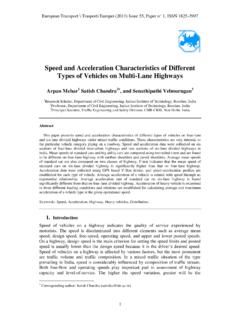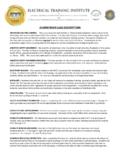Transcription of Advanced materials of automobile bodies in volume …
1 European Transport \ Trasporti Europei (2014) Issue 56, Paper n 10, ISSN 1825-3997 1 Advanced materials of automobile bodies in volume production Savkin Alexey Nikolaevich1, Andronik Artem Valerievich1 , Gorunov Andrey Igorevich2, Sedov Alexander Alexandrovich1, Sukhanov Mikhail Alexandrovich1 1 Volgograd State Technical University 2 Kazan National Research Technical University named after Tupolev Abstract Nowadays even regular drivers informed about application of high strength and low density materials in automobile structures. The reasons for it are not only intention of automobile manufacturers to redivide a market for their benefits or advertising purpose, but adequate response to legal requirements regulating fuel economy growth and protection of environment. Aluminum automobile bodies , nonmetallic closures and interiors made of natural materials are emerging on roads and city streets.
2 However all these novelties are results of invisible but tremendous efforts of scientists, designers, product engineers, metallurgists, economists and marketing experts. If management decision of material selection is not based on deep analysis, then negative economic and technical effect are matters of course. Development onrush of traditional and alternative body materials complicates this decision even for expert. material selection for automobile body and related technical, economical and geographical details are outlined in the present paper. Latest advantages of metallurgy, polymer and composite manufacturing as well as safety, repair and recycling issues are briefly analyzed from automobile engineer standpoint. A number of scientists and technicians could be interested in collaboration programs between automobile , metallurgical, academical and government organizations oriented to developing of Advanced body designs and materials , so most prosperous of them are described below.
3 Analysis of modern automobile designs is given on the basis of all these data; moreover, forecast of future progress is completed. Attempt to cover all variety of up-to-date body materials , analyze and highlight the most promising of them for volume production was committed on small scale of the paper. Keywords: light weight material , material selection, automobile material , automobile trend. Abbreviations ABS Acrylonitrile Butadiene Styrene AHSS Advanced High Strength Steel AISI - American Iron and Steel Institute Corresponding author: Andronik Artem Valerievich European Transport \ Trasporti Europei (2014) Issue 56, Paper n 10, ISSN 1825-3997 2 BEV Battery electric vehicle BH Bake-hardening Steel BIW Body-in-white BMC Bulk Moulding Composite CAFE - Corporate Average Fuel Economy CFRP Carbon Fiber Reinforced Plastic CM Carbon-Manganese Steel CP Complex-phase Steel DP Double-phase Steel ECV Experimental Composite vehicle EISA - Energy Independence and Security Act EuroNCAP - European New Car Assessment Program FCV Full Cell vehicle FreedomCAR - Freedom Cooperative Automotive Research FRP Fiber Reinforced Plastic FSV FutureSteelVehicle GFRP Glass Fiber Reinforced Plastic HS IF High Strength Interstitial Free Steel HSLA High Strength Low Alloy Steel HSS - High Strength Steel ICE - Internal Combustion Engine IF - Interstitial Free Steel IISI - International Iron and Steel Institute LCA Life-Cycle
4 Analysis MILD Mild Steel MS Martensite Steel PA Nylone PC Polycarbonate PE Polyethylene PEV Plug-in electric vehicle PNGV - Partnership for a New Generation of Vehicles PP Polypropylene PPO - Polyphenylene Oxide PU Polyurethane PVC - Polyvinylchloride RRIM - Reinforced Reaction Injection Molding RTM - Resin Transfer Moulding SMC Sheet Molding Compound SS Stainless Steel TRIP Transformation Induced Plasticity Steel TWB Tailor Welded Blanks TWIP Twinning-Induced Plasticity steel UHSS Ultra High Strength Steel ULSAB - Ultra Light Steel Auto Body US DOE United States Department of Energy European Transport \ Trasporti Europei (2014) Issue 56, Paper n 10, ISSN 1825-3997 31. Introduction automobile body puts into life artistic skills and aesthetical insight of art-designer along general technical erudition and intimate technology knowledge of engineer-technician.
5 Though, as a rule, consumer is more concerned with appearance, ergonomics and comfort. At the same time, automobile engineer notices modest technical performance of structure. Undoubtedly, key factors of automobile volume production are cost, safety, volume production suitability and universal repairability. Furthermore, different problems appeared in distinct phases of automobile history and their solutions often had an impact on body design. In such a way, in postwar 1950s exhausted Europe restrained consumption of steel reducing automobile manufacturing (Foy, 2013). Many efforts undertook against corrosion occurrences in 1960-1970s, especially in the North-East of the USA, Canada and Europe. Governments concentrated on fuel economy after oil embargo of the Organization of Petroleum Exporting Countries against Israel allies in the October war of 1973 resulting in 4-time oil price leap and Iran revolution of 1978-1979 resulting in 2-time oil price leap (Hamilton, 2013).
6 In 1990s European automobile Manufacturers Association promoted ecological standards Euro inducing emission reduction of exhaust gas. In 2000s safety standards developed according to European New Car Assessment Programme (EuroNCAP) in spite of real resistance of automobile manufacturers (Hobbs and McDonough, 1998). At the present time stable steel production and modern corrosive-resistant body materials allowed announcing 12 years warranty against penetration (Davies, 1993). But fuel economy and protection of environment issues still engross minds of government organizations, corporations and customers. Emergence of alternative automobile power units, metallurgy and plastic fabrication successes, uprising of novel structures and technologies all of these generate variety of problem solutions.
7 For instance, enforcing Corporate Average Fuel Economy law (CAFE), which adopted in 1975, leads decreasing of automobile weight, popularization of fuel efficient cars and acceptance of electromobility concept (Klier и Linn, 2012). The Energy Independence and Security Act of the USA (EISA) passed in 2007 and looks forward to next fuel economy spurt by 2020. However demand for powerful engines, oversized and off-road automobiles is not descending in the USA. Moreover, Cooman et al. (2011) showed amazing growth of average curb weight up to 90% in Europe since 1970 to 2010! Therefore weight decreasing issue is a still contradictory and hotly debated matter. Euro ecological standards are widely used in the EU and out of borders. The UN Climate Change Conference (Mexico, Cancoon) in 2010 emphasized arising interests of the EU and the USA in environmental protection relating to automobile transport.
8 Let us consider that the USA is one of few countries that have not ratified Kyoto Protocol to the UN Framework Convention on Climate Change. Moreover, the UN Climate Change Committee (2010) informed that correlation between carbon dioxide in atmosphere and climate change is still not clearly established. Recent research of Russian ecologists showed that contemporary emission of carbon dioxide and nitrogen oxides has secondary contribution among other greenhouse gases (Fedorov et al, 2011). But nevertheless due to some unclear reasons developed countries push ambitious environmental laws, for example, the UK adopted the Energy White Paper in 2003 to achieve 60% reduction of CO2 emissions by 2050 (Harwatt et al, 2011). After all, such careless spending of budget funds seems wasteful.
9 European Transport \ Trasporti Europei (2014) Issue 56, Paper n 10, ISSN 1825-3997 4 Interestingly, automobile transport is a prevailing source of air pollution by nitrogen and carbon oxides, hydrocarbons, but it is correct for urban ecology only. Moreover, simple, but consistently observed actions in traffic regulation, public transport organization, road and city infrastructure can sufficiently decrease vehicle emissions both urban and overall (Singh, 2012). In worldwide and national scales fuel end energy sector and heavy industry confidently dominate among other artificial air contaminants (Fedorov et al, 2011). It becomes apparent that popularization of electric cars cannot resolve emission problem, but inflict it to other industrial sectors.
10 Hence reasons of ecological laws enforcing is unclear from industrial ecology standpoint. Here are basic fuel economy factors of automobile design: 1) aerodynamics; 2) rolling resistance of tyres; 3) weight; 4) drivetrain efficiency; 5) optimum operating point of engine; 6) ancillary equipment; 7) intermittent engine shutdown; 8) waste energy exploitation. There is a belief that fuel economy improvement follows the rule: weight decrease of 10% results in fuel economy of 6-7%. In such a manner fuel economy and emission concerns stipulate weight decreasing projects. Modern body-in-white (BIW) takes nothing less than 20% of gross vehicle weight (by the example of 1400 kg vehicle ) as in the fig. 1. And body consumes 63% of total usage of mild low-strength sheet steel in automobile (by the example of an average European van).




